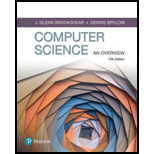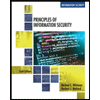
Computer Science: An Overview (13th Edition) (What's New in Computer Science)
13th Edition
ISBN: 9780134875460
Author: Glenn Brookshear, Dennis Brylow
Publisher: PEARSON
expand_more
expand_more
format_list_bulleted
Expert Solution & Answer
Chapter 1, Problem 7SI
Explanation of Solution
Data compression techniques:
The data compression techniques are lossless compression technique that does not lose any information during compression process. These techniques are reversible and data can be recovered or reconstructed any time.
The liability issues that might be raised:
The following issues can be raised while going for data compression.
- If the data compression results in loss of significant information then the loss of important information gives some unpredictable results and information to that person is not liable.
- There is always a cost associated with both compressing and decompression of the data which may be the cost of processing time, coding and decoding and licensing fees...
Expert Solution & Answer
Want to see the full answer?
Check out a sample textbook solution
Students have asked these similar questions
Considering the TM example of binary sum ( see attached)do the step-by-step of execution for the binary numbers 1101 and 11.
Feel free to use the Formal Language Editor Tool to execute it;
Write it down the current state of the tape (including the head position) and indicate the current state of the TM at each step.
I need help on inculding additonal code where I can can do the opposite code of MatLab, where the function of t that I enter becomes the result of F(t), in other words, turning the time-domain f(t) into the frequency-domain function F(s):
I need help with the TM computation step-by-step execution for the binary numbers 1101 and 11.
Formal Language Editor Tool can be used to execute it; Write it down the current state of the tape (including the head position) and indicate the current state of the TM at each step;
Chapter 1 Solutions
Computer Science: An Overview (13th Edition) (What's New in Computer Science)
Ch. 1.1 - What input bit patterns will cause the following...Ch. 1.1 - In the text, we claimed that placing a 1 on the...Ch. 1.1 - Assuming that both inputs to the flip-flop in...Ch. 1.1 - a. If the output of an AND gate is passed through...Ch. 1.1 - Prob. 5QECh. 1.1 - Prob. 6QECh. 1.2 - If the memory cell whose address is 5 contains the...Ch. 1.2 - Prob. 2QECh. 1.2 - Design a sequence of steps that correctly...Ch. 1.2 - How many bits would be in the memory of a computer...
Ch. 1.3 - Prob. 1QECh. 1.3 - Prob. 2QECh. 1.3 - Prob. 3QECh. 1.3 - Prob. 4QECh. 1.3 - Prob. 5QECh. 1.3 - Prob. 6QECh. 1.4 - Here is a message encoded in ASCII using 8 bits...Ch. 1.4 - In the ASCII code, what is the relationship...Ch. 1.4 - Prob. 3QECh. 1.4 - Prob. 4QECh. 1.4 - Convert each of the following binary...Ch. 1.4 - Prob. 6QECh. 1.4 - What is the largest numeric value that could be...Ch. 1.4 - An alternative to hexadecimal notation for...Ch. 1.4 - What is an advantage of representing images via...Ch. 1.4 - Prob. 10QECh. 1.5 - Convert each of the following binary...Ch. 1.5 - Convert each of the following base ten...Ch. 1.5 - Convert each of the following binary...Ch. 1.5 - Express the following values in binary notation:...Ch. 1.5 - Perform the following additions in binary...Ch. 1.6 - Convert each of the following twos complement...Ch. 1.6 - Prob. 2QECh. 1.6 - Suppose the following bit patterns represent...Ch. 1.6 - Suppose a machine stores numbers in twos...Ch. 1.6 - In the following problems, each bit pattern...Ch. 1.6 - Prob. 6QECh. 1.6 - Prob. 7QECh. 1.6 - Prob. 8QECh. 1.6 - Prob. 9QECh. 1.6 - Prob. 10QECh. 1.6 - Prob. 11QECh. 1.7 - Prob. 1QECh. 1.7 - Prob. 3QECh. 1.7 - Prob. 4QECh. 1.8 - What makes Python an interpreted programming...Ch. 1.8 - Write Python statements that print the following:...Ch. 1.8 - Write Python statements to make the following...Ch. 1.8 - Write a Python statement that given an existing...Ch. 1.9 - Prob. 1QECh. 1.9 - Prob. 2QECh. 1.9 - Prob. 3QECh. 1.9 - Prob. 4QECh. 1.9 - Prob. 5QECh. 1.9 - Prob. 6QECh. 1.9 - Prob. 7QECh. 1.10 - Prob. 1QECh. 1.10 - Could errors have occurred in a byte from Question...Ch. 1.10 - Prob. 3QECh. 1.10 - Prob. 4QECh. 1.10 - Prob. 5QECh. 1.10 - Prob. 6QECh. 1 - Determine the output of each of the following...Ch. 1 - a. What Boolean operation does the circuit...Ch. 1 - a. If we were to purchase a flip-flop circuit from...Ch. 1 - Assume that both of the inputs in the following...Ch. 1 - The following table represents the addresses and...Ch. 1 - How many cells can be in a computers main memory...Ch. 1 - Prob. 7CRPCh. 1 - Prob. 8CRPCh. 1 - Prob. 9CRPCh. 1 - Prob. 10CRPCh. 1 - Suppose a picture is represented on a display...Ch. 1 - Prob. 12CRPCh. 1 - Prob. 13CRPCh. 1 - If each sector on a magnetic disk contains 1024...Ch. 1 - How many bytes of storage space would be required...Ch. 1 - Prob. 16CRPCh. 1 - Prob. 17CRPCh. 1 - Suppose a typist could type 60 words per minute...Ch. 1 - Prob. 19CRPCh. 1 - Prob. 20CRPCh. 1 - Prob. 21CRPCh. 1 - Prob. 22CRPCh. 1 - Prob. 23CRPCh. 1 - Prob. 24CRPCh. 1 - Prob. 25CRPCh. 1 - Prob. 26CRPCh. 1 - Prob. 27CRPCh. 1 - Prob. 28CRPCh. 1 - Prob. 29CRPCh. 1 - Prob. 30CRPCh. 1 - Prob. 31CRPCh. 1 - Prob. 32CRPCh. 1 - Prob. 33CRPCh. 1 - Prob. 34CRPCh. 1 - Prob. 35CRPCh. 1 - Prob. 36CRPCh. 1 - Prob. 37CRPCh. 1 - Prob. 38CRPCh. 1 - Prob. 39CRPCh. 1 - Prob. 40CRPCh. 1 - Prob. 41CRPCh. 1 - Prob. 42CRPCh. 1 - Prob. 43CRPCh. 1 - Prob. 44CRPCh. 1 - Prob. 45CRPCh. 1 - What would be the hexadecimal representation of...Ch. 1 - Prob. 47CRPCh. 1 - Prob. 48CRPCh. 1 - Prob. 49CRPCh. 1 - Prob. 50CRPCh. 1 - Prob. 51CRPCh. 1 - Prob. 52CRPCh. 1 - Prob. 53CRPCh. 1 - Prob. 54CRPCh. 1 - Prob. 55CRPCh. 1 - Prob. 56CRPCh. 1 - Prob. 57CRPCh. 1 - Prob. 58CRPCh. 1 - Write and test a Python script that, given a...Ch. 1 - Prob. 61CRPCh. 1 - Prob. 2SICh. 1 - Prob. 3SICh. 1 - Prob. 4SICh. 1 - Prob. 5SICh. 1 - Prob. 6SICh. 1 - Prob. 7SI
Knowledge Booster
Similar questions
- Ensure you answer the question asked at the end of the document. Do not just paste things without the GNS3 console outputsarrow_forward"Do not use AI tools. Solve the problem by hand on paper only and upload a photo of your handwritten solution."arrow_forward"Do not use AI tools. Solve the problem by hand on paper only and upload a photo of your handwritten solution."arrow_forward
- "Do not use AI tools. Solve the problem by hand on paper only and upload a photo of your handwritten solution."arrow_forward"Do not use AI tools. Solve the problem by hand on paper only and upload a photo of your handwritten solution."arrow_forwardSolve this "Do not use AI tools. Solve the problem by hand on paper only and upload a photo of your handwritten solution."arrow_forward
- "Do not use AI tools. Solve the problem by hand on paper only and upload a photo of your handwritten solution."arrow_forward"Do not use AI tools. Solve the problem by hand on paper only and upload a photo of your handwritten solution."arrow_forwardSpecifications: Part-1Part-1: DescriptionIn this part of the lab you will build a single operation ALU. This ALU will implement a bitwise left rotation. Forthis lab assignment you are not allowed to use Digital's Arithmetic components.IF YOU ARE FOUND USING THEM, YOU WILL RECEIVE A ZERO FOR LAB2!The ALU you will be implementing consists of two 4-bit inputs (named inA and inB) and one 4-bit output (named out). Your ALU must rotate the bits in inA by the amount given by inB (i.e. 0-15).Part-1: User InterfaceYou are provided an interface file lab2_part1.dig; start Part-1 from this file.NOTE: You are not permitted to edit the content inside the dotted lines rectangle. Part-1: ExampleIn the figure above, the input values that we have selected to test are inA = {inA_3, inA_2, inA_1, inA_0} = {0, 1, 0,0} and inB = {inB_3, inB_2, inB_1, inB_0} = {0, 0, 1, 0}. Therefore, we must rotate the bus 0100 bitwise left by00102, or 2 in base 10, to get {0, 0, 0, 1}. Please note that a rotation left is…arrow_forward
arrow_back_ios
SEE MORE QUESTIONS
arrow_forward_ios
Recommended textbooks for you
 Systems ArchitectureComputer ScienceISBN:9781305080195Author:Stephen D. BurdPublisher:Cengage Learning
Systems ArchitectureComputer ScienceISBN:9781305080195Author:Stephen D. BurdPublisher:Cengage Learning Principles of Information Systems (MindTap Course...Computer ScienceISBN:9781305971776Author:Ralph Stair, George ReynoldsPublisher:Cengage Learning
Principles of Information Systems (MindTap Course...Computer ScienceISBN:9781305971776Author:Ralph Stair, George ReynoldsPublisher:Cengage Learning Fundamentals of Information SystemsComputer ScienceISBN:9781337097536Author:Ralph Stair, George ReynoldsPublisher:Cengage Learning
Fundamentals of Information SystemsComputer ScienceISBN:9781337097536Author:Ralph Stair, George ReynoldsPublisher:Cengage Learning Enhanced Discovering Computers 2017 (Shelly Cashm...Computer ScienceISBN:9781305657458Author:Misty E. Vermaat, Susan L. Sebok, Steven M. Freund, Mark Frydenberg, Jennifer T. CampbellPublisher:Cengage Learning
Enhanced Discovering Computers 2017 (Shelly Cashm...Computer ScienceISBN:9781305657458Author:Misty E. Vermaat, Susan L. Sebok, Steven M. Freund, Mark Frydenberg, Jennifer T. CampbellPublisher:Cengage Learning Principles of Information Security (MindTap Cours...Computer ScienceISBN:9781337102063Author:Michael E. Whitman, Herbert J. MattordPublisher:Cengage Learning
Principles of Information Security (MindTap Cours...Computer ScienceISBN:9781337102063Author:Michael E. Whitman, Herbert J. MattordPublisher:Cengage Learning C++ for Engineers and ScientistsComputer ScienceISBN:9781133187844Author:Bronson, Gary J.Publisher:Course Technology Ptr
C++ for Engineers and ScientistsComputer ScienceISBN:9781133187844Author:Bronson, Gary J.Publisher:Course Technology Ptr

Systems Architecture
Computer Science
ISBN:9781305080195
Author:Stephen D. Burd
Publisher:Cengage Learning

Principles of Information Systems (MindTap Course...
Computer Science
ISBN:9781305971776
Author:Ralph Stair, George Reynolds
Publisher:Cengage Learning

Fundamentals of Information Systems
Computer Science
ISBN:9781337097536
Author:Ralph Stair, George Reynolds
Publisher:Cengage Learning

Enhanced Discovering Computers 2017 (Shelly Cashm...
Computer Science
ISBN:9781305657458
Author:Misty E. Vermaat, Susan L. Sebok, Steven M. Freund, Mark Frydenberg, Jennifer T. Campbell
Publisher:Cengage Learning

Principles of Information Security (MindTap Cours...
Computer Science
ISBN:9781337102063
Author:Michael E. Whitman, Herbert J. Mattord
Publisher:Cengage Learning

C++ for Engineers and Scientists
Computer Science
ISBN:9781133187844
Author:Bronson, Gary J.
Publisher:Course Technology Ptr